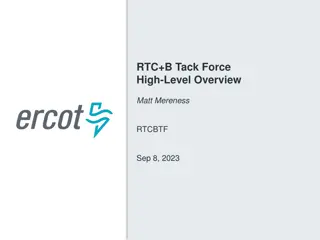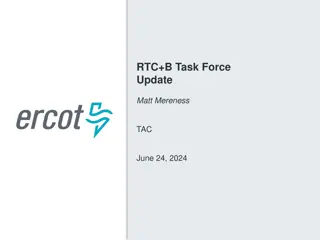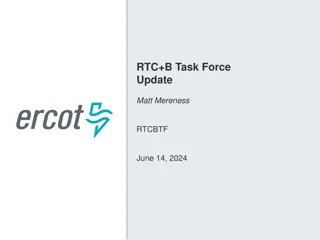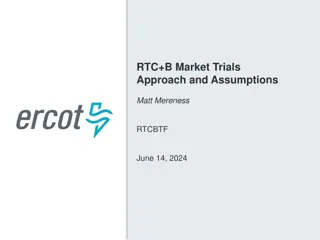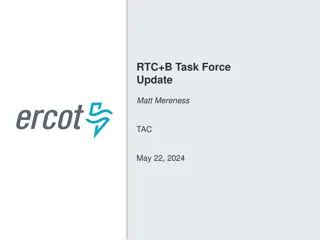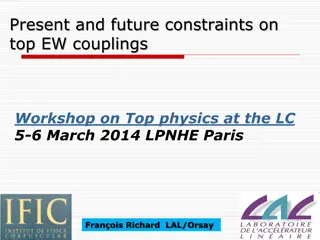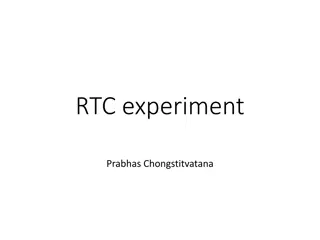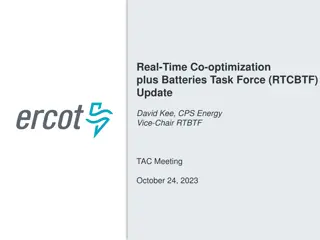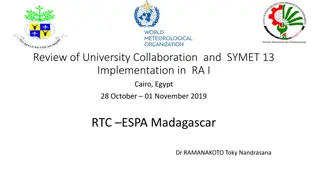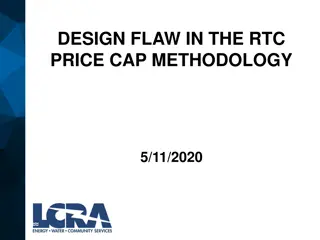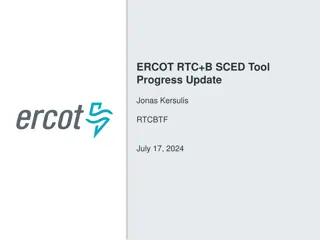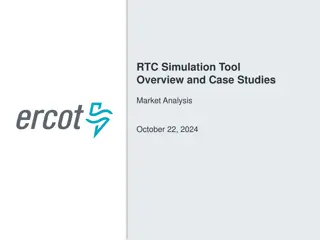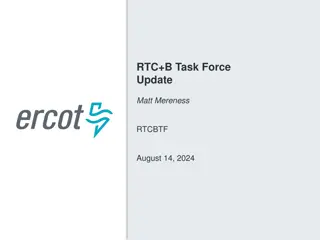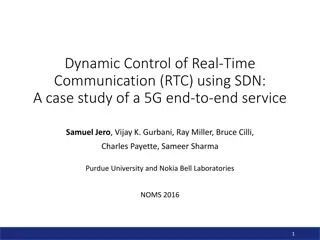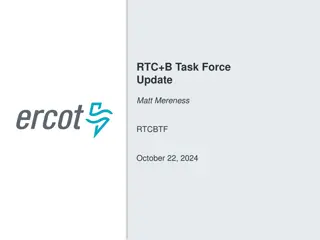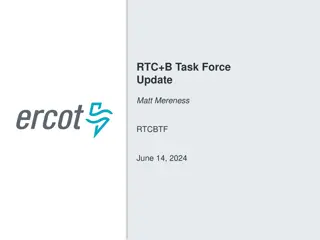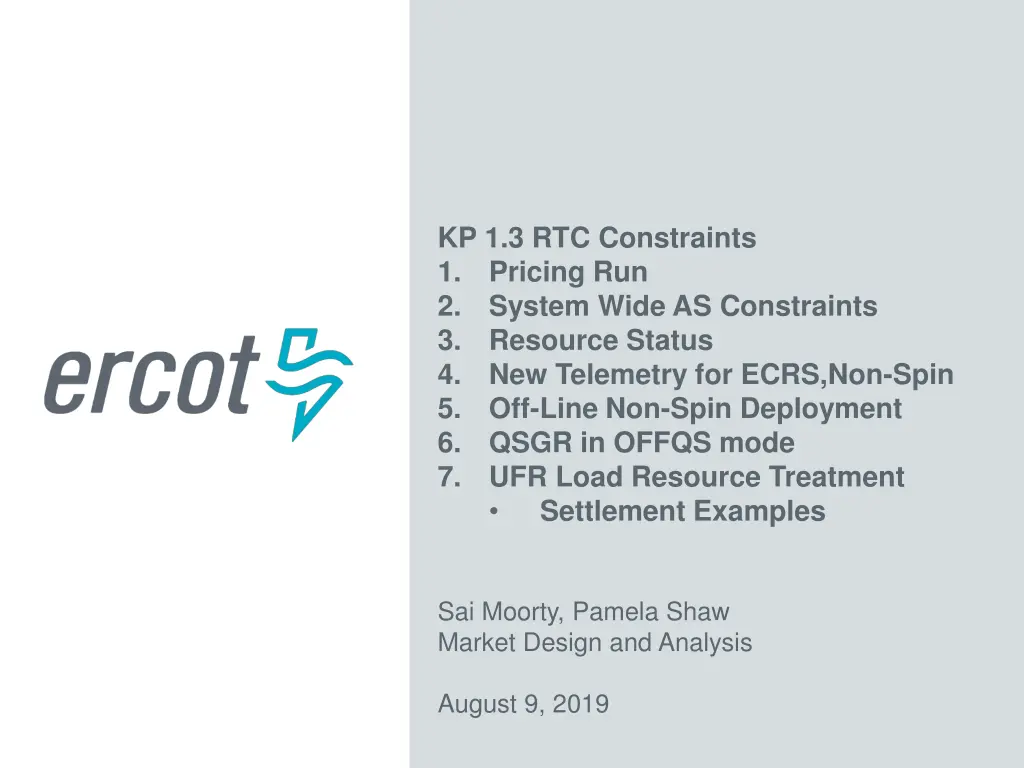
Pricing Run NPRR 626 Under RTC - System Wide Impacts Analysis
Explore the impacts of Pricing Run NPRR 626 under the Real-Time Co-optimization (RTC) framework, analyzing system-wide pricing impacts and changes to current pricing runs to enhance energy and Ancillary Services (AS) management. Learn about the intent, adjustments, and final pricing considerations outlined in the document.
Download Presentation

Please find below an Image/Link to download the presentation.
The content on the website is provided AS IS for your information and personal use only. It may not be sold, licensed, or shared on other websites without obtaining consent from the author. If you encounter any issues during the download, it is possible that the publisher has removed the file from their server.
You are allowed to download the files provided on this website for personal or commercial use, subject to the condition that they are used lawfully. All files are the property of their respective owners.
The content on the website is provided AS IS for your information and personal use only. It may not be sold, licensed, or shared on other websites without obtaining consent from the author.
E N D
Presentation Transcript
KP 1.3 RTC Constraints 1. Pricing Run 2. System Wide AS Constraints 3. Resource Status 4. New Telemetry for ECRS,Non-Spin 5. Off-Line Non-Spin Deployment 6. QSGR in OFFQS mode 7. UFR Load Resource Treatment Settlement Examples Sai Moorty, Pamela Shaw Market Design and Analysis August 9, 2019
ERRATA: July 12th Posting of KP1.3 Constraint Examples KP1.3 PowerPoint presentation corrected and reposted to July 12th RTCTF meeting page: http://www.ercot.com/content/wcm/key_documents_lists/180266/KP_1.3_Contraint s_Examples-corrected_examples.pptx Example 3 and Example 6 results corrected 2 ERCOT Public
Items For Discussion This presentation is based on the working document RTC_Constraints_KP1.3_080919_v3.docx posted to the August 9, RTCTF meeting page http://www.ercot.com/content/wcm/key_documents_lists/180260/RTC_constraints _KP1.3_080919_v3.docx 1. 2. 3. 4. 5. 6. 7. Pricing Run System Wide AS Constraints Resource Status New Ramp Rate Telemetry for ECRS, Non-Spin Off-Line Non-Spin Deployment QSGR in OFFQS mode UFR Load Resource Treatment Settlement Examples 3 ERCOT Public
Pricing Run (NPRR 626) Under RTC Intent, like today, is to capture system wide pricing impacts on energy and each AS type MCPC when out-of-market actions are taken Note: Changes to current Pricing Run (locational impacts, others) will be analyzed and the intent of these changes will be incorporated into RTC. Proposal for Pricing Run Under RTC: No Make Whole payment to Resources (Same as today) Reliability Deployment Price Adder (RDPA) for Resource headroom does not exist anymore Same categories of reliability deployments that initiate pricing run as today (6.5.7.3.1) 4 ERCOT Public
Pricing Run (NPRR 626) Under RTC Change inputs to pricing run: Relax HDL/LDL for certain On-Line Resources (6.5.7.3.1) ONRUC/On-Line RMR Resource: LSL,LDL set to zero (Refer to Protocols for combined cycle RUCed to different configuration) Remove AS Offers or high priced AS Offers ERS and UFR type Load Resource deployed due to ERCOT XML Instruction (RRS/ECRS) Remove AS offers or high priced AS Offers GTBD (same as today): Add deployed MW (as per ERCOT XML Instruction) to GTBD(e.g. relax LSL of ONRUC to zero, modify HDL/LDL of certain Resources, etc.) Modify GTBD related to out of market actions on DC Ties and Block Load Transfers Rerun Step1 and Step2 (energy and AS co-optimization) 5 ERCOT Public
Pricing Run (NPRR 626) Under RTC Final Pricing: energy and each AS type Energy: If Pricing Run RTC Step2 Power Balance Shadow price (System Lambda) is greater than the Dispatch Run RTC Step 2 System Lambda then add the positive difference to the Dispatch Run RTC Step 2 System Lambda with check to ensure that the final System Lambda does not exceed VOLL If the proposal to reduce System Lambda when System Lambda of Dispatch RTC Run Step 2 is greater than VOLL is adopted (KP1_1 and KP1_2 discussion), then the determination of the positive difference in System Lambda is performed after the reduction of Dispatch Run RTC Step 2 System Lambda ??? ??????? ??? ????? 2 ??? ??????? ??? ? = ??? 0, ????? 2 ??? ??????? ???+ ? ??????= ??? ????,????? 2 ??????= ?????? ????? 2 LMP Price Adder ??? ??????? ??? ?? ? ?? ??? ??????? ??? ???? 2 ?????= ?????? ???? ??? ?=1 6 ERCOT Public
Pricing Run (NPRR 626) Under RTC For each AS type (RegUp, RegDn, RRS, ECRS, and Non-Spin), if the AS type MCPC from Pricing Run Step 2 is greater than the corresponding AS type MCPC from the Dispatch RTC Run Step 2 then add the positive difference to the Dispatch RTC Run Step 2 AS Type MCPC with check to ensure that the final AS type MCPC does not exceed that AS type maximum price on its AS Demand Curve (ASDCAS-type) If the proposal to reduce AS MCPC when System Lambda of Dispatch RTC Run Step 2 is greater than VOLL is adopted (KP1_1 and KP1_2 discussion), then the determination of the positive difference in MCPC is performed after the reduction of Dispatch Run RTC Step 2 AS type MCPC ???? 2 ??? ??????? ??? ?????? ???? ???? 2 ??? ??????? ??? ?????? ????= ??? 0, ?????? ???? ????? ?????? ???? = ??? ?????????????? ????,?????? ???? ???? 2 ??? ??????? ???+ ?????? ???? MCPCAS-type Price Adder ???? 2 ??? ??????? ??? ????? ????? ?????? ???? = ?????? ???? ?????? ???? 7 ERCOT Public
System Wide AS Constraints $/MW/h AStype Supply MW Offer Awarded = AStype Demand MW Awarded Astype Demand Curve AStype Demand MW Awarded Astype MCPC $/MW/h Astype Supply MW Offer Awarded MW 8 ERCOT Public
System Wide Regulation Up Service (RegUp) Constraints Regulation Up Service (RegUp) has two (2) sub-types RegUp: Conventional RegUp, provided by On-Line Generation Resource, On-Line Controllable Load Resource FRRSUp: Fast Responding Regulation Up Service Rules on awarding RegUp A maximum amount of 65 MW of FRRSUp can be procured Two constraints for implementing the Rules for awarding RegUp ??????? 1. 1. ???????????? + + ?????????????= = ????????? 2. 2. ????????????? ?? 9 ERCOT Public
System Wide Regulation Down Service (RegDn) Constraints Regulation Down Service (RegDn) has two (2) sub-types RegDn: Conventional RegDn, provided by On-Line Generation Resource, On-Line Controllable Load Resource FRRSDn: Fast Responding Regulation Down Service Rules on awarding RegDn A maximum amount of 35 MW of FRRSDn can be procured Two constraints for implementing the Rules for awarding RegDn ??????? 1. 1. ???????????? + + ?????????????= = ????????? 2. 2. ????????????? ?? 10 ERCOT Public
System Wide Responsive Reserve Service (RRS) Constraints Responsive Reserve Service (RRS) has three (3) sub-types Primary Frequency Response (RRS-PFR) from Generation Resource and Controllable Load Resource RRS from Load Resources (RRS-BLK) armed with high set Under Frequency Relay (UFR) - UFR setting at 59.7 Hz and must deploy within 30 cycles (0.5 seconds). Fast Frequency Response (RRS-FFR) from very fast responding Resources. Frequency setting at 59.85 Hz and must deploy within 15 cycles (0.25 seconds) Rules on awarding RRS A minimum of 1150 MW of RRS-PFR is required to be procured A maximum amount of 60% of the total RRS requirement can be procured from the combined RRS-BLK plus RRS-FFR In addition, the maximum amount of RRS-FFR that can be procured is (MAX-RRS-FFR) 11 ERCOT Public
System Wide Responsive Reserve Service (RRS) Constraints Three constraints for implementing the Rules for awarding RRS ??????? 1. ????? ????????+ ????? ????????+ ????? ????????= ??????? 2. The maximum allowable RRS from the sum of RRS-BLK and RRS-FFR is capped at MIN(60% of Total_RRS_Req, (Total_RRS_Req 1150)) ????? ????????+ ????? ????????<= MIN(0.6 Total_RRS_Req, (Total_RRS_Req 1150)) Total_RRS_Req. (a) Min RRS-PFR (b) Total_RRS_Req RRS-PFR (c) 60% of Total_RRS_Req (d). Min(c,d) RRS-BLK+RRS-FFR <= Min(c,d) Ex. 1 2300 MW 1150 MW 1150 MW 1380 MW 1150 MW Ex. 2 2840 MW 1150 MW 1690 MW 1704 MW 1690 MW Ex. 3 3000 MW 1150 MW 1850 MW 1800 MW 1800 MW 3. The maximum allowable RRS of RRS-FFR type is MAX-RRS-FFR ????? ???????? MAX RRS FFR 12 ERCOT Public
System Wide Responsive Reserve Service (RRS) Constraints For each UFR Load Resource, the total RRS award is ??? ?????????????+ ??? ??? ??????? ??? ???= ??? ??? Note 1: For every RTC run, a UFR Load Resource RRS-BLK award is the sum of the validated self-provided RRS-BLK and additional RRS-BLK award Note 2: AS Imbalance settlement process for UFR Load Resource, will use the RRS-BLK Award output from each RTC run 13 ERCOT Public
System Wide Responsive Reserve Service (RRS) Constraints $/MW/h RRS ASDC 1150 Total_RRS_Req. 60% 100% MW Total awards for RRS-BLK+RRS-FFR capped at lesser of 60% of Total_RRS_Req or Total_RRS_Req-1150 14 ERCOT Public
System Wide ERCOT Contingency Reserve Service (ECRS) Constraints ERCOT Contingency Reserve Service (ECRS) has two (2) sub-types ECRS: Conventional ECRS, i.e., RTC Dispatchable (On-Line or OFFQS Generation Resource, On-Line Controllable Load Resource) ECRS-BLK: Manually Dispatched (On-Line UFR type Load Resource) Rules on awarding RRS No more than 50% of total ECRS requirements can be procured from On- Line UFR type Load Resources Two constraints for implementing the Rules for awarding ECRS ??+????+????????? ??????? ????????? + + ?=1 ???? ????????= = ???????? ??????? 1. ?=1 ??????? ???? ???????? 0.5 ????? ????_??? 2. ?=1 15 ERCOT Public
System Wide ERCOT Contingency Reserve Service (ECRS) Constraints For each UFR Load Resource, the total ECRS award is ???? ?????????????+ ??? ???? ??????? ???? ???= ??? ??? Note 1: For every RTC run, a UFR Load Resource ECRS-BLK award (??? ECRS-BLK and additional ECRS-BLK award Note 2: AS Imbalance settlement process for UFR Load Resource, will use the total ECRS-BLK Award (??? each RTC run ???? ???) is the sum of the validated self-provided ???? ???) output from 16 ERCOT Public
System Wide Non-Spin Reserve Service (Non-Spin) Constraints Non-Spin Reserve Service (Non-Spin) can be provided by: On-Line and OFFQS Generation Resource, Off-Line Non-Spin Qualified Generation Resource , On-Line Controllable Load Resource, One constraint for implementing the Rules for awarding Non-Spin ??+????+??????+??????? ??????????= = ????????? ??????? 1. ?=1 17 ERCOT Public
Review Use of Generation Resource Statuses under RTC Some feedback provided so far: Need to ensure that RTC has a check that estimation of PRC from available AS Offers is greater than the actual PRC, otherwise RTC dispatch is invalid related to AS participation rules/Proxy AS Offer Consider use of existing status telemetry of Raise Block Status (RBST) and Lower Block Status (LBST) in RTC to limit Base Point and AS awards Currently, used only in LFC for the intra 5 minute period to freeze UDBP On proposed new telemetry to limit AS awards by RTC, are all of them required? Why would a QSE provide a Resource specific telemetry limiting awards for ECRS but the HDL for Resource indicates it can receive a Base Point higher than its current output level ? Before finalizing list of Resource Statuses and proposed new telemetry a combined review of interactions required Consider a new Resource Status indicating transition (ONTR). For this status RTC will not award any AS and Base Point = telemetered output 18 ERCOT Public
Review Use of Generation Resource Statuses under RTC Resource Status ON ONOPTOUT Proposed use of Generation Resource Status under RTC Available for energy and AS awards Considered to be same as ON Considered to be same as ON (may have special treatment, e.g., AS offer floors) Considered to be same as ON for energy, ECRS and NSPIN. Cannot be awarded Regulation or Responsive Reserve Not available to for energy, Regulation, Responsive Reserve, or ECRS awards Available for NSPIN if qualified Energy participation same as today. Cannot be awarded AS by RTC. ONRUC OFFQS OFF ONTEST Considered to be same as ON,Not eligible for AS award QSE may appropriately set LSL and HSL to reflect operating limits Not available for energy or AS awards Not available for energy or AS awards Energy participation same as today. Cannot be awarded AS (BP=telMW+5*RRup) Exception is when OFF Resource deployed for Non-Spin and OFFQS awarded BP>0 Energy participation same as today. Cannot be awarded AS (BP=telMW-5*RRdn) Not available for energy or AS awards ONEMR OUT EMR STARTUP SHUTDOWN EMRSWGR 19 ERCOT Public
Review Use of Generation Resource Statuses under RTC Resource Status Proposal to remove the following Generation Resource Status under RTC Status no longer needed Status no longer needed Status no longer needed Status no longer needed Status no longer needed ONREG FRRSUP ONOSREG ONDSRREG OFFNS 20 ERCOT Public
Review Use of Generation Resource Statuses under RTC Resource Status ONOS Needs more discussion: Energy participation same as today. Today, can carry all AS products. What should be the case with RTC? Today, Resource with status of ONOS generally do not submit Inc/Dec EOC. Under RTC, if awarded ECRS, Non-Spin, RTC will hardly ever convert this capacity to energy due to economics Energy participation same as today. Todays can carry all AS products. What should be the case with RTC? There does not seem to be any Resource using this status Status no longer needed? Hydro in Synchronous Condenser mode. Today, BP=telMW. Under RTC, setting BP=telMW, i.e.; RTC does not dispatch Resource for energy, allows for Resource to be awarded RRS-PFR, however more discussion required if Resource wishes to participate in ECRS to determine how capacity awarded ECRS will be converted to energy if RTC cannot dispatch. Hydro in Synchronous Condenser mode. See notes on ONRR. More discussion required on both energy and AS participation. How is ECRS awarded capacity converted to energy? Status no longer needed ? Replace with ON? ONDSR ONRR ONECRS ONFFRRRS 21 ERCOT Public
Review Use of Load Resource Statuses under RTC Resource Status Proposed use of Load Resource Status under RTC Replace with ON ONRL Replace with ON ONRGL Replace with ON. Similar to GR with ON status ONCLR Replace with ON ONECL Replace with ON ONFFRRRSL Not available for energy or AS, already captured in Generation Resource statuses Status no longer needed OUT FRRSDN Status no longer needed FRRSUP Feedback requested: Please review table of Resource status and ERCOT comments and provide feedback 22 ERCOT Public
AS Offer Structure a) On-Line Upward AS Offer: RegUp, RRS, ECRS, Non-Spin On-Line Generation Resource (RegUp,RRS-PFR,ECRS,Non-Spin) On-Line Controllable Load Resource (RegUp,RRS-PFR,ECRS,Non-Spin) UFR type Load Resource (RRS-BLK, ECRS-BLK) Fast Resources (RRS-FFR) OFFQS Generation Resource (ECRS, Non-Spin) co-optimized with Energy Offer Curve (EOC) b) On-Line Down AS Offer: RegDn On-Line Generation Resource On-Line Controllable Load Resource c) Off-Line AS Offer: ECRS, Non-Spin Off-Line Non-Spin qualified Generation Resource (Non-Spin) 23 ERCOT Public
On-Line Upward AS Offer Structure And Constraints AS Offer MW (up to 5 per Resource) RegUp Price ($/MW/h) RRS Price ($/MW/h) ECRS Price ($/MW/h) Non-Spin Price ($/MW/h) ASMW1 RegUpPrice1 RRSPrice1 ECRSPrice1 Non-SpinPrice1 ASMW2 RegUpPrice2 RRSPrice2 ECRSPrice2 Non-SpinPrice2 ASMW3 RegUpPrice3 RRSPrice3 ECRSPrice3 Non-SpinPrice3 ASMW4 RegUpPrice4 RRSPrice4 ECRSPrice4 Non-SpinPrice4 ASMW5 RegUpPrice5 RRSPrice5 ECRSPrice5 Non-SpinPrice5 Constraints: ??????????+ ??? ??? ????????+ ??? ?????????+ ??? ?????????? ?????; i = 1, 2, 3, 4, 5 ??? ??????????= ?=1 ?????????? ?=5??? Resource RegUp Award: ??? Same setup for: On-Line RegDn AS Offer Off-Line ECRS,Non-Spin AS Offer ??? ????????= ?=1 ?=5??? ??? ???????? Resource RRS Award: ??? ?????????= ?=1 ?=5??? ????????? Resource ECRS Award: ??? ??????????= ?=1 ?=5??? ?????????? Resource Non-Spin Award: ??? 24 ERCOT Public
Basic AS Award Constraints Resource RegUp Award* ?????????? ??? ???????????,?????????????????, ?????? 5 Resource RegDn Award* ?????????? ??? ???????????,?????????????????, ?????? 5 Resource RRS-PFR Award* ??? ??? ??? ???????? ??? ?????????,???????????????,20% ??? * There are additional Resource level constraints for RegUp, RegDn, RRS-PFR ??? Resource ECRS Award ????????? ??? ??????????,????????????????, ?????? 10 10 ??? Resource Non-Spin Award ?????????? ??? ???????????,?????????????????, ?????? 30 30 ??? New: ERRUp10 , Emergency Ramp Rate (MW/Min) reflecting 10 minute capability New: NRRUp30 , Normal Ramp Rate (MW/Min) reflecting 30 minute capability 25 ERCOT Public
New Proposed Ramp Rate Telemetry To Check Feasibility Of ECRS And Non-Spin Awards 10: ?????? Blended Emergency Ramp Rate Up (value, when multiplied by 10 shows the 10 minute MW output change capability) of ith Resource. Used to check feasibility of ECRS awards 30: ?????? Blended Normal Ramp Rate Up (value, when multiplied by 30 shows the 30 minute MW output change capability) of ith Resource. Used to check feasibility of Non-Spin awards Feedback requested: Is the provision of the additional new telemetry acceptable? Are there other alternatives ? 26 ERCOT Public
Off-Line Non-Spin Deployment Non-Spin Award based on economics, Off-Line AS Offer and 30 min Ramp Rate capability HSL Non-Spin Award based on economics, On-Line AS Offer and 30 min Ramp Rate capability Off-Line Gen ERCOT XML: Deploys Non-Spin Output MW 25 min. to LSL LSL ON, EOC co-optimized with On-Line AS Offer OFF, 0MW RTC 25 RTC 30 RTC 35 RTC 20 RTC 15 RTC 10 RTC 5 RTC 0 Time 27 ERCOT Public
Off-Line Non-Spin Deployment Upon ERCOT Instruction to deploy Off-Line Non-Spin: Resource must be On-Line @ LSL within 25 minutes of ERCOT XML instruction Resource will be on On-Line status until ERCOT XML Recall During STARTUP Resource Status, Resource is eligible to be awarded Non-Spin. This eligibility lasts for 25 minutes from the time of ERCOT instruction to deploy Non-Spin from Off-Line Generation Resource During STARTUP, RTC will determine Non-Spin Award based on Non-Spin Offer Price from the Resource On-Line AS Offer. i.e. will NOT use Off-Line AS Offer 28 ERCOT Public
QSGR Treatment in OFFQS Resource Status OFFQS is treated by RTC in the same manner as an On-Line Generation Resource with the following exceptions : Cannot be awarded Regulation Cannot be awarded RRS OFFQS is eligible to be awarded ECRS and Non-Spin using ECRS and Non-Spin prices from its On-Line Upward AS Offer During the transition period from OFFQS to ON, i.e. Resource Status is STARTUP: During STARTUP, QSGR will continue to be eligible for ECRS and Non-Spin awards using ECRS and Non-Spin prices from its On- Line Upward AS Offer 29 ERCOT Public
QSGR Treatment in OFFQS Resource Status Discussion Item: ECRS is a 10 minute product. Currently, QSGRs have a 10 minute window to respond to non-zero Base Points. Should this 10 minute window apply to QSGRs that are given a Non-Zero Base Point that have been awarded ECRS? 30 ERCOT Public
UFR Load Resource Treatment Under RTC UFR Load Resources are eligible to participate in RRS-BLK and ECRS-BLK AS markets UFR Load Resource can be awarded both RRS-BLK and ECRS-BLK for their curtailable load amount Note that upon deployment, irrespective of whether the deployment is for RRS-BLK or ECRS-BLK, the full amount of curtailable load is deployed Two ways in which RRS-BLK are deployed and recalled: RRS-BLK Automatic Self deployment: Low Frequency event causes UFR to trip ERCOT systems does not get explicit information from QSE that UFR trip has occurred ERCOT operations monitoring the grid usually detect UFR trips for large events, for smaller events, a UFR trip may go unnoticed. In such cases, QSE informs ERCOT operations that UFR trip has occurred UFR Load Resource remains deployed (curtail load) until ERCOT operations issues recall instruction (currently a phone call) After ERCOT issued recall instruction (currently a phone call), UFR Load Resource has up to 3 hours to come back into service 31 ERCOT Public
UFR Load Resource Treatment Under RTC RRS-BLK ERCOT operations directed deployment (not through RTC economic dispatch) : ERCOT operations issues XML deployment instruction for RRS-BLK UFR Load Resource remains deployed (curtail load) until ERCOT operations issues XML recall instruction After ERCOT issued XML recall instruction, UFR Load Resource has up to 3 hours to come back into service ECRS-BLK deployment: UFR Load Resources with relay armed and providing ECRS-BLK can be deployed automatically on frequency or manually by ERCOT operations ERCOT operations directed deployment (not through RTC economic dispatch) : ERCOT operations issues XML deployment instruction for ECRS-BLK UFR Load Resource responds by curtailing all available load UFR Load Resource remains deployed until ERCOT operations issues XML recall instruction After ERCOT issued XML recall instruction, UFR Load Resource has up to 3 hours to come back into service 32 ERCOT Public
UFR Load Resource Treatment Under RTC Self Provision of RRS-BLK and ECRS-BLK at individual UFR Load Resource level Impractical to arm and disarm UFR every 5 minutes and have UFR Load Resources participate actively in RTC Proposal is to allow self-provision of RRS-BLK and ECRS-BLK based on DAM RRS- BLK, ECRS-BLK awards, RRS-BLK, ECRS-BLK AS Trades and DAM Self-arranged RRS-BLK, ECRS-BLK within a QSE Self-provision MW quantities of RRS-BLK, ECRS-BLK is telemetered to ERCOT by QSE for each UFR Load Resource in its portfolio: ??????????: Telemetry to indicate RRS-BLK MW amount self-provided by On-Line UFR type Load Resource ???????????: Telemetry to indicate ECRS-BLK MW amount self-provided by On- Line UFR type Load Resource 33 ERCOT Public
UFR Load Resource Treatment Under RTC Note that validation steps depend on validated AS trades and Self- Arrangement within QSE for RRS_BLK and ECRS-BLK to ensure limits on these services have been checked before confirming these AS Trades ERCOT is working on designing a validation process Validation of telemetered self-provision of RRS-BLK and ECRS-BLK at every RTC run Step 1 : At QSE portfolio level, check if sum of telemetered self provision of RRS is less than or equal to QSE s RRS-BLK responsibility from DAM RRS-BLK awards, validated RRS-BLK AS Trades and Self-arrangement within QSE. Similar check for ECRS-BLK If not, determine a step 1 validated self-provision amount (???????????1, ????????????1), (reduce the submitted telemetry values) QSE RRS QSE ECRS LR 1 Self Prov Tel. LR 2 Self Prov. Tel. LR 1 Validated - 1 LR 2 Validated - 1 TelSelfRRS TelSelfECRS TelSelfRRS TelSelfECRS V1-RRS V1- ECRS V1-RRS V1- ECRS DAM & AS Trade DAM & AS Trade Ex. 1 40 20 20 10 20 10 20 10 20 10 EX. 2 40 20 25 15 20 10 20 10 20 10 34 ERCOT Public
UFR Load Resource Treatment Under RTC Step 2 : For each UFR Load Resource, check if ???????????1+ ????????????1 ??? ??? If not, further revise to get step 2 validated self-provision amount (??????????v2, ???????????v2) LR 1 Validated - 1 LR1 LR 1 Validated - 2 LR 2 Validated - 1 LR 2 LR 2 Validated 2 V1-RRS V1-ECRS NPF-LPC V2-RRS V2-ECRS V1-RRS V1-ECRS NPF-LPC V2-RRS V2-ECRS Ex. 1 20 10 41 20 10 20 10 15 15 0 EX. 2 20 10 21 20 1 20 10 60 20 10 Step 3 : System wide check. If ??????????v2> ????????????? ??? + ??? then, prorate down all Step 2 validated RRS-BLK self-provision amounts to satisfy this limit and get the FINAL validated self-provision amount for RRS-BLK (??? ??? ???????) If ???????EC??v2> 0.5 ????? ????_??? then, prorate down all Step 2 validated ECRS-BLK self-provision amounts to satisfy this limit and get the FINAL validated self-provision amount for ECRS-BLK (??? ???? ???????) 35 ERCOT Public
UFR Load Resource Treatment Under RTC RTC awards to UFR Load Resource ??? ???????+ additional RRS-BLK award RRS-BLK award =??? Additional RRS-BLK award possible if headroom (discounting self-provided total AS) available, RRS offer exists, and economics ???? ???????+ additional ECRS-BLK award ECRS-BLK award =??? Additional ECRS-BLK award possible if headroom (discounting self-provided total AS) available, ECRS offer exists, and economics LR1 LR 1 Validated - 2 LR 1 LR 2 LR 2 Validated 2 LR 2 NPF-LPC V2-RRS V2-ECRS NPF-LPC V2-RRS V2-ECRS Extra AS (RRS+ECRS) eligibility Extra AS (RRS+ECRS) eligibility Ex. 1 41 20 10 11 15 15 0 0 EX. 2 21 20 1 0 60 20 10 30 36 ERCOT Public
UFR Load Resource Treatment Under RTC UFR Load Resource - no deployment RTC run will procure AS based on ASDC and validated AS self- provision MW eligible for additional ECRS / RRS award QSE subject to AS Imbalance Charge MPC NPF Validated ECRS Self Prov Tel. ECRS Self Prov Validated ECRS Self Prov = Tel. ECRS Self Prov 0 Validated RRS Self Prov Tel. RRS Self Prov Validated RRS Self Prov = Tel. RRS Self Prov LPC RTC 25 RTC 30 RTC 20 RTC 15 RTC 10 RTC 5 RTC 0 Time 37 ERCOT Public
UFR Load Resource Treatment Under RTC Summary of UFR Load Resource - no deployment Each RTC run will award UFR Load Resource RRS-BLK and ECRS-BLK equal to the sum of the final validated self-provision of RRS-BLK and ECRS-BLK, and potentially additional RRS-BLK, ECRS-BLK AS Imbalance Charge/Payment to QSE will use the RTC AS capacity awards for RRS- BLK and ECRS-BLK 38 ERCOT Public
UFR Load Resource Treatment Under RTC UFR Load Resource ERCOT XML Deployment (RRS-BLK or ECRS-BLK) ERCOT XML Recall @ time Y ERCOT XML Deployment (MW Deploy amount= @ RTC 0 Total ECRS_UFR+RRS_UFR Award) MW eligible for additional ECRS / RRS award Recall Period (3 Hr) Deployment Duration During Recall period (3 hours) 10 min. to deploy RTC run will procure AS based on ASDC and validated AS self-provision MPC NPF QSE subject to AS Imbalance Charge Validated ECRS + RRS Self Prov = Tel. ECRS+RRS Self Prov Tel. ECRS Self Prov + Tel. RRS Self Prov QSE can avoid AS Imbalance Charge by moving Self- Provision (ECRS+RRS) to another qualified UFR Load Resource after Recall XML Instruction During XML Deployment RTC + RTC Pricing Run (Using MW deployment from XML) During deployment period, UFR Load Resource total ECRS_UFR, RRS_UFR award = @ RTC 0 award Validated ECRS + RRS Self Prov LPC RTC Y+3 Hr RTC X RTC Y+5 RTC Y+2Hr, 55min RTC 15 RTC 10 RTC 5 RTC 0 Time 39 ERCOT Public
UFR Load Resource Treatment Under RTC Summary of UFR Load Resource ERCOT XML Deployment (RRS-BLK or ECRS-BLK) Each RTC run will award UFR Load Resource RRS-BLK and ECRS-BLK equal to the sum of the final validated self-provision of RRS-BLK and ECRS-BLK, and potentially additional RRS-BLK, ECRS-BLK AS Imbalance Charge/Payment to QSE will use the RTC AS capacity awards for RRS- BLK and ECRS-BLK During Deployment period: Dispatch Run RTC will output the UFR Load Resource AS awards (RRS-BL,ECRS-BLK) to be equal to the ERCOT XML Instruction amount. These AS MW capacity awards are used in Settlements Pricing Run is triggered during deployment period During Recall period: Pricing Run is NOT triggered Actual validated self-provision of RRS-BLK and ECR-BLK is used in RTC and Settlements QSE may be subject to AS Imbalance Charge (Buy Back) can be avoided by moving self- provision to another UFR Load Resource during Recall period 40 ERCOT Public
UFR Load Resource Treatment Under RTC UFR Load Resource Automatic Self Deployment Due To UFR Trip ERCOT Recall by Phone Call@ time Y Automatic Self Deployment Due to UFR Trip MW eligible for extra ECRS / RRS award Recall Period (3 Hr) Deployment Duration MPC NPF During Recall period (3 hours) RTC run will procure AS based on ASDC and validated AS self- provision Validated ECRS + RRS Self Prov = Tel. ECRS+RRS Self Prov Tel. ECRS Self Prov + Tel. RRS Self Prov QSE subject to AS Imbalance Charge QSE can avoid AS Imbalance Charge by moving Self-Provision (ECRS+RRS) to another qualified UFR Load Resource after Recall By Phone Call Validated ECRS + RRS Self Prov. = 0 Validated ECRS + RRS Self Prov LPC RTC Y+3 Hr RTC X RTC Y+5 RTC Y+2Hr, 55min RTC 15 RTC 10 RTC 5 RTC 0 Time 41 ERCOT Public
UFR Load Resource Treatment Under RTC Summary of UFR Load Resource Automatic Self Deployment Due To UFR Trip Each RTC run will award UFR Load Resource RRS-BLK and ECRS-BLK equal to the sum of the final validated self-provision of RRS-BLK and ECRS-BLK, and potentially extra RRS-BLK, ECRS-BLK AS Imbalance Charge/Payment to QSE will use the RTC AS capacity awards for RRS- BLK and ECRS-BLK During Deployment and Recall period: Pricing Run is NOT triggered Actual validated self-provision of RRS-BLK and ECR-BLK is used in RTC and Settlements QSE may be subject to AS Imbalance Charge (Buy Back) can be avoided by moving self- provision to another UFR Load Resource during Recall period 42 ERCOT Public
Summary Of Key Principles From This Presentation (KP1.1) Pricing Run The existing process of having a pricing run to capture the effects of reliability deployments will continue. However, the pricing run will be modified to also co-optimize energy and AS. To account for the co-optimization in the pricing run, the following modifications will be made to the inputs: AS offers from RUC-instructed Resources, including RMR Resources, will be removed for the pricing run AS offers from Load Resources on UFRs that have been manually deployed by ERCOT for RRS or ECRS will be removed for the pricing run (KP1.1) Real-time AS settlement will no longer include the Reliability Deployment Price Adder. Instead, the MCPCs for AS resulting from including the impacts of the pricing run will be used for real-time AS imbalance settlement. 43 ERCOT Public
Summary Of Key Principles From This Presentation (KP1.3) RTC will not change limitations on sub-categories of AS products (e.g., FRRS, FFR, and RRS and ECRS provided via UFR). (KP1.4) To better understand ramp capability for determining ECRS and Non- Spin awards, the following new telemetry points will be needed for Resources providing those services: A blended 10-minute Emergency Ramp Rate Up for the Resources that will be used to check the feasibility of ECRS awards. This value will be the 10- minute output change capability of the Resource divided by 10 (positive change for Resources injecting into the grid and negative change for Resources withdrawing from the grid). A blended 30-minute Normal Ramp Rate Up for the Resources that will be used to check the feasibility of Non-Spin awards. This value will be the 30- minute output change capability of the Resource divided by 30 (positive change for Resources injecting into the grid and negative change for Resources withdrawing from the grid). 44 ERCOT Public
Summary Of Key Principles From This Presentation (KP1.3) Off-line Resources providing Non-Spin that are in startup due to a manual deployment of Non-Spin by ERCOT will continue to be eligible for being awarded Non-Spin for the first 25 minutes following the deployment. The eligible capacity will be based on the HSL of the Resource less its base point instruction. (KP1.3) Resources operating in quick-start mode that are in startup due to a deployment from ERCOT will continue to be eligible for being awarded ECRS and Non-Spin. The eligible capacity will be based on the HSL of the Resource less its base point instruction. (KP1.3) For Load Resources providing AS via a UFR that are deployed for the AS through a manual instruction from ERCOT: During the period of deployment, the real-time optimization will continue to award the Load Resource AS with the awards based on the ERCOT instruction amount. During recall of the deployment, AS awards will not be based on the deployment amount. Instead, AS awards will be based on self-provision amounts and limited by the physical capability of the Resource to provide AS. 45 ERCOT Public
Discussion ERCOT Public

